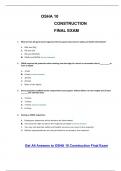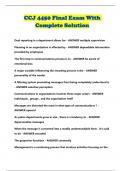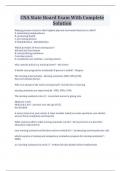BOB DE WIT AND RON MEYER
Fifth edition
,Inhoudsopgave
Chapter 1: Introduction, blz. 2-10 ....................................................................................................... 3
Chapter 1.1: Complexity: The nature of real world problems (Mason & Mitroff) .............................. 4
Chapter 7: Strategy Formation, blz. 339-348 ...................................................................................... 6
Chapter 11: The Organizational Context, blz. 550-553 ....................................................................... 8
Chapter 11.1: Defining leadership and explicating the process (Cyert) .............................................. 9
Chapter 3: Missioning and Visioning, blz. 118-125 ........................................................................... 11
Chapter 3.1: The social responsibility of business is to increase its profits (Friedman) ................... 13
Chapter 3.2: Stockholders and stakeholders: A new perspective on corporate
governance (Freeman & Reed) ......................................................................................................... 14
Chapter 3.3: Creating shared value (Porter & Kramer) ..................................................................... 17
Artikel Mitchell R., Angle B, Wood, D. 1999, blz. 863-879 ................................................................ 21
Chapter 1.3: Cultural constraints in management theories (Hofstede) ............................................ 24
Artikel The Benefits of ‘Guanxi’, Davies et al. 1995 .......................................................................... 27
Chapter 12.1 The globalization of markets (Levitt) ........................................................................... 29
Chapter 12.2 The myth of globalization (Douglas & Wind)............................................................... 30
Chapter 6.1 Collaborate with your competitors – and win (Hamel, Doz en Prahalad) ..................... 33
Chapter 6.2 Creating a strategic centre to manage a web of partners (Lorenzoni & Baden-Fuller) 35
Chapter 9.1 Kaizen (Imai) .................................................................................................................. 37
Artikel Dyer & Nabeoka (2000) blz. 360-366..................................................................................... 41
Chapter 4: Business level strategy, blz. 170-180, 188-189................................................................ 43
Chapter 5.1 (4th edition) Competitive strategy (Porter) .................................................................... 47
Chapter 4: Business level strategy, blz. 190-191 ............................................................................... 51
Chapter 4.2: Firm resources and sustained competitive advantage (Barney) .................................. 52
Chapter 5.1: Strategy and the business portfolio (Hedley) ............................................................... 54
Chapter 4.1: Strategy from the outside in (Day and Moorman) ....................................................... 55
Chapter 5.2: The core competence of the corporation (Prahalad and Hamel) ................................ 58
Chapter 10.2: Blue ocean strategy (Kim and Mauborgne) ................................................................ 60
Pagina 2 van 62
,Chapter 1: Introduction, blz. 2-10
‘Strategy’ cannot be summarized into broadly agreed-on definitions, rules, matrices and flow
diagrams that one must simple adsorb and learn to use.
‘Tools driven’: understanding each tool comes first, while combining them to solve the real
problems comes later. (eerst theorie, daana praktijk).
‘Problem driven’: understanding problems comes first, while searching for the appropriate
tools is based on the type of problem.
In het boek worden three dimensions of strategy aangegeven; three dimensions of strategy that can
be recognized in every real-life strategic problem situation:
Strategy content: the combined decisions and choices that lead a company into the future
are referred to as the strategy content. ‘What is, and should be, the strategy for the company
and each of its constituent units?’.
Strategy process: the manner in which strategies come about is referred to as the strategy
process. ‘The how, who and when of strategy’.
Strategy context: the set of circumstances under which both the strategy content and the
strategy process are determined is referred to as the strategy context.
Only the understanding of all three dimensions will give the strategist real depth of
comprehension (begrip).
Strategies can be made for different groups of people or activities within an organization. The lowest
level of aggregation is one person or task, while the highest level of aggregation (samenstelling)
encompasses all people or activities within an organization.
The most common distinction between levels of aggregation made in the strategic management
literature is between the functional, business and corporate levels (zie figuur 1.2. blz 7).
- Functional level: operations strategy, marketing strategy, financial strategy, etc.
- Business level: requires the integration of functional level strategies for a distinct set of
products and/or services intended for a specific group of customers.
- Corporate level: the same as business level, only in corporate level the companies are focus
in two or more businesses.
Firms often cluster together into groups of two or more collaborating organizations (strategy is
developed for group of firms): network level.
In reality, these levels of strategy do not exist as tidy categories, but are strongly interrelated
and partially overlapping.
Pagina 3 van 62
,Strategy process:
- Strategy analysis stage: strategists identify the opportunities and threat in the environment,
as well as the strengths and weaknesses of the organization.
- Strategy formulation stage: strategists determine which strategic options are available to
them, evaluate each and choose on.
- Strategy implementation stage: the selected strategic option is translated into a number of
concrete activities, which are then carried out.
Ook bij dezen drie fases is sprake van overlapping.
Volgens het boek worden veranderingen gelimiteerd door de cultuur, politiek en cognitieve erfenis
van een bedrijf.
Chapter 1.1: Complexity: The nature of real world problems (Mason & Mitroff)
‘Basically, every real world policy problem is related to every other real world problem. It means that
every time a policymaker attempts to solve a particular policy problem he or she must consider its
potential relationship with all other problems.
In reality, organization in complexity can become an insurmountable (onoverkomelijk) barrier to the
solution of a problem. This is the major challenge to real world problem solving because we have
very few intellectual tools for coping with ‘organized complexity’.
The tools we have available seem to work best on simple problems, those that can be
separated and reduces to relatively few variables and relationships. These problems of
simplicity usually have a one-dimensional value system or goals structure that guides the
solution.
Ironically, problems of the utmost complexity can also be tamed as long as the complexity is
‘disorganized’. That is, whenever the number of variables is very large and the variables are relatively
disconnected, the problem can be tamed with the elegant simplicity of statistical mechanics. (Als
voorbeeld wordt gegeven de voorspelling die gedaan kan worden bij verkiezingen).
‘Today, however, the insurance industry is discovering that many of the risks once assumed to be
reasonably independent and hence analysable according to standard actuarial methods are no longer
so. People, organizations and facilities have become more tightly woven together over wider
geographical areas’.
- Een consequentie daarvan is dat bij mogelijke gebeurtenissen die in een organisatie
plaatsvinden (overlijden, ongeval, brand of ramp) niet snel oplosbaar zijn.
- De statistische methodes die onder deze voorbeeld omstandigheden zijn ontstaan, zijn
minder betrouwbaar geworden omdat het tegenwoordig niet meer gaat om
‘ongeorganiseerde problemen’ maar ‘georganiseerde problemen’.
Een onderdeel van deze georganiseerde problemen zijn ook de verschillende systemen die binnen de
organisatie een eigen leven beginnen te leiden; ook wel ‘environmental connectedness’ en ‘turbulent
environment’.
Organized complexity, ook wel ‘wicked problems genoemd’; these problems simply cannot be tamed
in the same way that other problems can.
Wicked; like the head of a hydra, they are an ensnarled web of tentacles. The more you
attempt to tame them, the more complicated they become.
Pagina 4 van 62
,Rittel (1972) has identified several characteristic properties of wicked problems that distinguish
them from tame problems:
1. Ability to formulate the problem;
2. Relationship between problem and solution;
3. Testability; the solution to a tame problem can be tested, either it is correct or it is false;
4. Finality;
5. Tractability (handelbaarheid);
6. Explanatory characteristics;
7. Level of analysis;
8. Reproducibility (reproduceerbaarheid);
9. Replicability (herhaalbaarheid);
10. Responsibility.
Characteristics of wicked problems:
1. Interconnectedness (verwevenheid); strong connections link each problem to other problems.
2. Complicatedness (gecompliceerdheid);
3. Uncertainty (onzekerheid); wicked problems exist in a dynamic and largely uncertain
environment, which creates a need to accept risk, perhaps incalculable risk;
4. Ambiguity (dubbelzinnigheid); problems can be seen in quite different ways, different for each
person;
5. Conflict; a need to trade off ‘goods’ against ‘bads’ within the same value system;
6. Societal constraints (maatschappelijke beperkingen); social, organizational and political
constraints and capabilities, as well as technological ones, are central both to the feasibility and
the desirability of solutions.
‘Feedback loops’: connected circle, a change tends to multiply itself or perhaps even cancel itself out.
De ‘wicked problems’ van een georganiseerde complexiteit heeft twee grote gevolgen ‘major
implications’ voor het proces rondom beleid:
1. There must be a broader participation of affected parties, directly and indirectly, in the policy
making process.
2. Policy making must be based on a wider spectrum of information gathered from a larger
number of diverse sources.
Individuals are part of the problem and hence must be part of the solution.
Objectification (verwezenlijking) has the advantages of being explicit, providing a memory,
controlling the delegation of judgements, and raising pertinent issues that might have been
ignored otherwise.
In dealing with problems of organized complexity one should start with ‘Descartes rule’: accepteer
nooit iets als er twijfel is; voor de oplossing van wicked problems is de methode van twijfel de beste
garantie. ‘Systematizing doubt’:
Making information and its underlying assumptions explicit;
Raising questions and issues toward which different positions can be taken;
Gathering evidence and building argument for and against each position;
Attempting to arrive at some final conclusion.
In policy making these processes of dialectics and argumentations are inescapable.
In addition to the need for participation by a variety of parties and the existence of diverse
information sources, two other characteristics of wicked problems should be noted: (1) one is that
Pagina 5 van 62
, they must be dealt with in a holistic (integrale) or synthetic way as well as in an analytic way. (2)
second is that there is some form of latent (verborgen) structure within them.
Quest for new methods; some new criteria for the design of real world problem-solving methods:
1. Participative: the methods must incorporate the active involvement of groups of people;
2. Adversarial (hoor en wederhoor): twijfel is de garantie.
3. Integrative (integratie): a unified set of assumptions and a coherent plan of action are
needed to guide effective policy planning and strategy making.
4. Managerial mind supporting: it is the policymakers thinking process and his or her mind that
needs to be supported.
Chapter 7: Strategy Formation, blz. 339-348
‘Strategy is a course of action for achieving an organization’s purpose’. ‘
‘Intended strategy (strategy formulation) is what individuals or organizations formulate prior to
action (a pattern of decisions), while realize strategy (strategy formation) refers to the strategic
behaviour exhibited in practice (a pattern of actions)’.
‘In short, for managers, finding a way to realize a strategic pattern of actions is the key issue’.
Strategy formation activities:
Process of strategy into four categories of activities: identifying, diagnosing, conceiving and realizing.
Tijdens het structureren van het proces moet rekening gehouden worden met de ‘many involving
people’ met verschillende ervaringen, perspectieve, persoonlijkheden, interesses en waarden.
De ‘strategy formation activities’ kan naast de vier categorieën nog worden onderverdeeld:
1. ‘Identifying: refers to all activities contributing to a better understanding of what should be
viewed as problematic’. The key activities here are:
Mission setting: wat de organisatie ziet als probleem is de basis van de missie.
Agenda setting: ‘besides the organizational mission as a screening mechanism, many other
factors can contribute to the focusing of organizational attention on specific strategic
issues. (zoals de cognitieve map van de strategist en de groepscultuur).
Pagina 6 van 62






